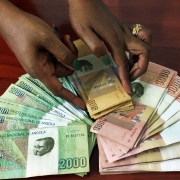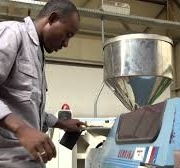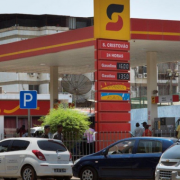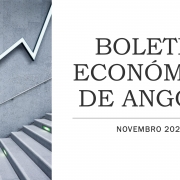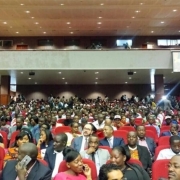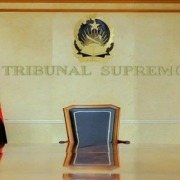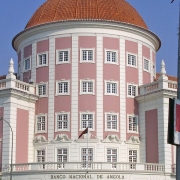China and Angola: understanding a complex relationship in times of world polarisation
Rui Verde ( African Studies Centre, University of Oxford) – Palestra proferida da Fundação Rui Cunha em Macau, 22 de Maio de 2023.

This is a summary of some of the findings of a work in progress about the relations between Angola and China since the beginning of the 2000s that I am developing at the University of Oxford. It will deal with three themes: the beginning of the strong economic relations between the two countries, the perceptible consequences and the present-day situation.
The beginning
It would not be correct to begin an analysis of the relations between China and Angola at the beginning of the 21st century without briefly considering the countries’ previous interactions.
Referring just to the People’s Republic of China, and not Imperial China and the endeavours of Admiral Zheng He in the fifteenth century, it should be noted that at least from the 1960s, China had some interest and influence in Angola, and vice versa. The famous trip that Chou En-Lai made to Africa in 1963–1964, which WAC Adie referred to as ‘Chou En-Lai’s Safari, resulted in the first intense contemporary Chinese approach to the African continent and gave rise to two types of movement regarding Angola, then a Portuguese colony under a liberation war.
Portugal, the authoritarian colonial power at war in Angola, entertained the notion of establishing diplomatic relations with communist China. The Portuguese leaders tried to advance into a kind of Nixon–Kissinger avant la lettre, but in the end, they were held back by opposition from the US.
The Angolan liberation movements, meanwhile, started to count on the support of China in terms of arms and training. In the initial phase, China had no strong preference and helped all of the movements, including the MPLA, FNLA and UNITA.
From a certain point onwards, given that the Soviet Union had ‘put all its eggs in the MPLA basket’, China mainly opted to support UNITA as a form of counterbalance to the Soviets. Nevertheless, China’s diplomatic actions were mostly pragmatic, and its attempts to create relations with the FNLA and MPLA continued over the years.
With Angola’s independence in 1975, and the country’s transformation into a Cold War camp, Chinese diplomacy found itself in a dilemma. China did not want to support the United States, but it certainly considered the Soviets to be its primary enemy. It therefore adopted a public discourse of peace and fraternity and turned against the MPLA, since it considered the organisation too pro-Soviet.
Relations with the new government in Luanda were uninspiring; in fact, Beijing ignored it for a time.
The resumption of relations was gradual and without special intensity. The final step in the process of the normalisation of Sino–Angolan relations was the visit of President Jose Eduardo dos Santos to Beijing in October 1988. Although the visit was cordial, it was not received with warmth. During the 1990s, China was undergoing a significant domestic reformist process, and interactions with Angola were not a priority.
Accordingly, there is no historical basis on which to predict that China would become Angola’s most important economic partner and to define a possible model for intervention in Africa.
From initially being very poor, China’s relationship with the MPLA government went on to became lukewarm, although there was no indication of closeness.
However, quite surprisingly, with the end of the civil war in Angola in 2002, the country turned to China for economic support, which China delivered in what became an ongoing relationship.
The official explanation for this sudden seemingly close relationship is usually framed within the paradigm of a rational state that makes institutional decisions. It has been explained by some academics that the Angolan regime turned to the IMF to finance the country’s post-war reconstruction; however, dissatisfied with the IMF’s demands of accountability and transparency and the unwillingness of the fund to compromise and accommodate Angolan wishes, Angola opted to obtain financing from China in a state-to-state agreement.
The reality seems more complex, however. When it ended the civil war, Angola did not have a functional and institutional state, and a good part of the state functions were ‘privatised’ and handed over to external entities, thereby enabling what is now called ‘state capture’. For example, diamond security was ensured by Arkady Gaydamak (Russian-born French Israeli businessman, and perhaps spy from several agencies), the supply of weapons by Pierre Falcone (French businessman) and various real estate and financial aspects by the Espírito Santo Financial Group, in which the company ESCOM and its strongman Hélder Bataglia stood out.
Alongside this ‘privatisation’ of state functions, José Eduardo dos Santos, as with other members of the Angolan elite, distrusted the West and its institutions.
This is the context of the understanding with China.
The relationship was a kind of private venture that met the wishes of Dos Santos, who did not want to be dependent on the IMF or the West. For him, the approach to China was a matter of national security.
Therefore, two points should be made. The first is that Dos Santos chose not to resort to the IMF due to considerations of national security; that is, the Angolan President did not want to be too dependent on the West.
The second and most crucial point is that Angola managed some of the advantages brought by China largely as a private fiefdom. Apparently, the initial contacts for this purpose had been promoted by the then-president of ESCOM, Bataglia, and the international arms trafficker, Pierre Falcone, of the famous Angolagate case.
However, Angola presented an official façade to China. Initially, a financing agreement was established between EximBank and the Angolan Ministry of Finance for the amount of US$2 billion, which was approved by the Angolan Council of Ministers in March 2004. At the same time, the Angolan Ministry of Public Works signed a contract with a Chinese company, Jinagsu International, for the construction of the Palace of Justice in Luanda. These two moves are the first to have been referenced by the government’s official gazette, Diário da República, within the scope of this new Sino–Angolan relationship.
On the Chinese side, its interest in Angola was not specific, according to the Chinese sources we have interviewed, but it was based on the following three essential aspects:
- Its international economic policy, which was designed by Mao Zedong in ‘On the Ten Major Relationships’, in which he declared: ‘We must learn to do economic work from all who know how, no matter who they are.’ Obviously, it was also a result of the Four Modernisations that ended in Jiang Zemin’s policy of Go Out and China’s accession to the WTO in 2001.
- Its need for oil and raw materials (which Angola had in abundance) to sustain Chinese growth.
- Its surplus of people and capital that was ready to be invested.
For Angola’s part, the criminal case that was launched in the summer of 2022 against Generals Kopelipa and Dino, the former strongmen of Dos Santos, made clear the private mechanisms that gave rise to the intense relations between Angola and China. It was explained that on the Angolan side, Bataglia of ESCOM, with Manuel Vicente (the CEO of Sonangol and the future vice-president of the country) and Eugénio Neto, another man from ESCOM, conducted a famous first visit to China. It was during this visit that the whole strategy of collaboration between the two countries was outlined.
A multitude of companies were established with the Angolan leaders Vicente, Kopelipa and Dino at their head (the latter is said to have been a figurehead for Dos Santos). For instance, the China International Fund (CIF) and China Sonangol are private entities created at that time by Vicente, Kopelipa and Dino, albeit with supposedly official designations.
The point is that aside from the official agreements, there was a parallel relationship that became substantively relevant because the actions were not conducted between states but by private entities between them.
The perceptible consequences
Naturally, the consequences of the China’s engagement in Angola have been extremely positive for the reconstruction of the country after the civil war (1975–2002). Chinese companies have built 2800 kilometres of railways, 20,000 kilometres of roads, more than 100,000 social housing projects, more than 100 schools and more than 50 hospitals in Angola. The Kaculo Kabaça Hydroelectric Power Plant, Agostinho Neto International Airport, cities of Kilamba Kiaxi and Zango 5, Benguela railway, port of Caio, Soyo power plant and many other cooperation projects have been successfully implemented. Many Chinese companies have invested in Angola and made important contributions to the country’s economic diversification and industrialisation[1].
Nevertheless, some iconic works and activities that have resulted from this Sino–Angolan collaboration have become symbols of rampant corruption, since some of Angola’s high public officials took advantage of and siphoned off various funds into corrupt activities.
Two examples illustrate this. The first naturally concerns the purchase and sale of oil. According to the findings of the current Angolan authorities, between 2004 and 2007, when Manuel Vicente led the Angolan oil company Sonangol, he authorised the sale of oil to China amounting to at least €1.5 billion, which was paid by China but diverted. During this period, Sonangol sold huge numbers of barrels of crude oil to China Sonangol International Holding Limited as a consignment sale for the constitution of a national reconstruction fund. Sonangol delivered the oil to the company but did not receive payment following its delivery. The intermediary company sold the oil and kept the money from the sale, which was then credited to its accounts at the Bank of China. The intermediary company belonged to Vicente and Kopelipa and some other partners.
Documents still under study, to which I had access, indicate that from 2005 to 2010, the sale of Angolan oil to China generated more than US$85 billion. Of this amount, probably at least US$25.7 billion was reported to have been split between Angolan leaders through a web of schemes woven by various intermediaries.
In another situation, the company CIF Limited, which was apparently mostly owned by Angolan ministers, appropriated 24 state buildings built by the company Guangxi in the centrality of Zango. The state paid for the construction, but it was Delta Imobiliária (a company owned by Vicente, Dino and Kopelipa) that sold the buildings to Sonangol EP through Sonip Lda under Vicente’s guidance for a total amount of US$475,347,200[2].
What is certain is that from the U$2 billion dollars of credit in 2005, Angola held US$23 billion of public debt stock in China in 2017[3].
After Xi Jinping assumed the Chinese leadership, steps were taken to root out corruption, and Chinese authorities neutralised the corrupt elements, such as Sam Pa (a business magnate who is believed to be the head of the 88 Queensway Group) that would have aided Angolans in these schemes. Chinese authorities also send auditing teams to Angola to survey the oil purchases.
Present-day situation
The advent of João Lourenço’s presidency encompassed an attempt to reopen Angola to the West. Nevertheless, this did not imply a downgrading of relations with China, as some recent studies have suggested, expounding a certain uneasiness from the Angolan perspective towards China. Carvalho et al. spoke of a ‘marriage of convenience’; Silva stated that ‘Angola’s honeymoon with China [had come] to an end’; and Fabri said ‘The China–Angola Honeymoon is over; is Africa listening?[4]”
Again, the reality is not so straightforward. There has surely been a rebalancing of the relations, but this has come from both parties and has not signalled an end to their relationship.
The opening act of Lourenço’s presidency towards China in 2017–2018 was apparently to ask for more money. There had initially been an alleged new loan from China worth US$11 billion, which later turned out to be US$2 billion, but this only served to pay Angola’s debts to Chinese companies.
However, China’s containment was not new to Angola and had nothing to do with João Lourenço, as some now claim. In 2016, the China Development Bank had suspended funds from credit lines to Angola, namely to Sonangol, accusing the company and the Angolan Ministry of Finance of non-compliance with the contracts. Previously, in 2015, as mentioned earlier, Chinese auditors were said to have been in Angola to ascertain the extent of the Sinopec’s spending there. They suspected several items of wrongdoing, for instance that the Chinese oil company had paid an additional almost US$1 billion to finance a quota that Sam Pa, through China Sonangol International, had acquired in certain Angolan oil blocks that did not bear profits.
These attitudes seem to indicate that there was some prudence or restraint on the part of China vis-a-vis Angola businesses.
Nevertheless, afterwards, China was generous in suspending the payment of the Angolan external debt due to the pandemic. Also, Chinese banks agreed to some form of debt renegotiation.
Trade between China and Angola grew by 42% in 2021 and continued at a good pace in the first six months of 2022, with a homologous increase of 33%. In this way, China continued to be Angola’s main economic partner.
Moreover, figures from Angola’s central bank show that since 2020, the country has paid as much as US$2 billion of capital to China. Presently, according to the most recent numbers put forward by the Angolan Minister of Finance, Angola is taking advantage of higher oil prices to accelerate its debt-reduction plans and smooth out repayments to China, its largest creditor.
Angola now owes China $18 billion, or about 40% of its total external debt, after it settled loans totalling $1.32 billion in 2022[5].
All these data show that Angola’s relations with China are now entering a new phase—one that is mature but not ending.
It turns out that this new phase does not depend only on Lourenço’s willingness to open up to the West or on Angola’s uneasiness with China, as some have argued; it also depends on Chinese engagements and worldwide strategy.
It is important to address first the question of the so-called ‘debt trap’ and then the most recent developments in the Sino–Angolan relationship.
The truth is that, like the Western creditors of the past in relation to Africa and Latin America, China is on a learning curve, and given the pragmatism that seems to guide its relations, it will be necessary for China to avoid dramatic scenarios and instead consider the usual remedies of debt renegotiation and forgiveness.
There is no room to mention a ‘debt trap’. It is known that in the 19th century, Great Britain was faced with debt problems from third countries, namely in Latin America and Egypt. The solution was often to send gunboats or to control the governance of the indebted countries.
By the end of the 20th century, the United States had large debt problems with countries of the so-called Third World. In this case, the solution was more rational, with its emphasis on the Brady Plan (Brady Bonds).
Obviously, it is now China’s turn to face the same issue, but there is no talk of gunboats or the creation of any protectorate.
Also, some parallel could be draw with the relations of the Soviet Union with President Nasser of Egypt. It is known that under Khrushchev, the Soviet Union largely financed Nasser and the Aswan Dam; however, afterwards, with Brezhnev, a new attitude prevailed that called for austerity and denied the postponement of debts payments. This, in the end, led to Sadat and the waning of Soviet influence in Egypt.
With such historical examples in mind, China is surely balancing its options, not opting for a disengagement. It is carefully assessing the situation and searching for the right economic and financial mechanisms to solve the problem, as the United States did in the 1980s.
In relation to Angola, it should be noted that one of the first trips of China’s new foreign minister, Qin Gang, was to Angola, last January, and at the same time, the respective governments signed an agreement whereby China would spend US$249 million to finance a national broadband project in Angola.
In short, it is apparent that the relations between China and Angola are evolving, not ending or reaching a dead-end, as some have argued. This is the time for careful calibration and renewal of the friendship.
If I can use a metaphor based on my favourite Portuguese wine, Palácio da Brejoeira, it can be said that Sino–Angolan relations enjoyed an initial phase of pure joy, then there was the hangover and now it is the time for some moderate drinking and sophistication among true connoisseurs.
[1] Shang, João (2023), A parceria estratégica entre China e Angola tem perspectivas amplas, coexistindo oportunidades e riscos. Communication to the III Congressso Internacional de Angolanística (not yet published)
[2] Summary of the legal case in Verde, Rui (2022), Delfins de JES acusados na hora da sua morte, https://www.makaangola.org/2022/07/delfins-de-jes-acusados-na-hora-da-sua-morte/
[3] Data from the National Bank of Angola, https://www.bna.ao/
[4] de Carvalho, P., Kopiński, D., & Taylor, I. (2022). A Marriage of Convenience on the Rocks? Revisiting the Sino–Angolan Relationship. Africa Spectrum, 57(1), 5–29.
Silva, Cláudio (2022), How Angola’s honeymoon with China came to an end, The Africa Report, https://www.theafricareport.com/202465/how-angolas-honeymoon-with-china-came-to-an-end/.
Fabri, Valerio, (2022), The China-Angola Honeymoon is over, is Africa listening?, Geopolitica.info,https://www.geopolitica.info/china-angola-honeymoon-over/
[5][5] Idem, see note 3.


